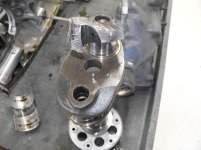Alpha Romeo
MEMBER
Vernonia, OR
Long time reader. First time poster here.
Had an engine failure in my PA-12 O-320. In flight 3 miles from my home airport developed severe engine knock and loosing power. No symptoms leading up to it, just sudden knock. Very blessed to make it home safely.
Had an engine shop tear down the engine and found that I now have a 2 piece crankshaft. Broke all the way through at the center main bearing. Does anyone know why or how this could have happened? I will try to attach pictures.
Also I am trying to locate a replacement crankshaft. If someone could point me in the correct direction I would really appreciate it. I posted an add in the classified section.



Had an engine failure in my PA-12 O-320. In flight 3 miles from my home airport developed severe engine knock and loosing power. No symptoms leading up to it, just sudden knock. Very blessed to make it home safely.
Had an engine shop tear down the engine and found that I now have a 2 piece crankshaft. Broke all the way through at the center main bearing. Does anyone know why or how this could have happened? I will try to attach pictures.
Also I am trying to locate a replacement crankshaft. If someone could point me in the correct direction I would really appreciate it. I posted an add in the classified section.












